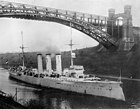Levensau High Bridge
Previous history
The lower section of the small river Levensau was extended between 1777 and 1784 to become part of the Eider Canal. Between 1887 and 1895 the Eider Canal was further extended and straightened to become part of the Kiel Canal (then Kaiser-Wilhelm-Kanal). The extended canal necessitated a fixed link for the Kiel–Flensburg railway as well as the principal road from Kiel to Eckernförde.
Historic pictures
Being a landmark on the Kiel canal, the bridge was depicted on postcards and also used as a popular background for pictures of ships transiting the canal.
-
The towers of the bridge, postcard from 1895
-
The bridge ca. 1900
-
Armoured cruiser
SMS Fürst Bismarck, 1909 -
Light cruiser
SMS Dresden, ca. 1912 -
Battleship
SMS Schleswig-Holstein, 1932
Design and construction
Construction of the bridge took 11⁄2 years. Work on the abutments was started in June 1893 and bricklaying lasted until end of that year. On top of the abutments the bridge featured four towers by architect Hermann Muthesius. The scaffolding that supported the steel elements during construction was erected from November 1893 and assembly of the steel construction started in May 1894. The bridge was inaugurated by Emperor Wilhelm II in December 1894. Originally the carriageway was designed in such a way that it could not be used by road and rail traffic simultaneously - if a train approached, the bridge was closed for cars and lorries. In the course of a first modification a barrier between road and railway was installed, however this limited the width of the road to 4.5 metres (15 ft) so that lorries were unable to pass each other on the bridge. Furthermore, the pedestrian way was only 90 centimetres (35 in) wide. In 1954, the bridge was extensively reworked to allow for independent use by road, rail and pedestrians. The towers were torn down and the carriageway was enlarged.
Replacement
In 1984 a four lane road bridge was opened for road traffic, taking over the role as main canal crossing for the Kiel–Schleswig road (route 76).
The current bridge is still used for the railway and local road traffic including bicycles. Its span is too short for the canal expansion to a width of 162 metres (531 ft). In 2009 the cost estimate for the replacement stood at 42 million Euros. The replacement of the old bridge with a substitute was decided in 2018. The replacement was also deemed necessary due to technical reasons. However, in addition to taking the geological condition of the subsoil into consideration the project also has to respect environmental aspects (for instance the presence of bats). The project itself with a number of illustrations and some information in English is presented by its engineers. There is also a direct webcam displaying the bridge and the current construction zone.
Bat habitat
Inside the old brick abutments a mixed colony of roughly 5,000 bats hibernate. The colony is protected under the Convention on International Trade in Endangered Species of Wild Fauna and Flora, CITES, and includes Microbats, Common nocturles, Daubenton bats and Natterer bats. The population was examined by scientists of the Kiel University and is considered the largest in Northern Europe.
Gallery
Contemporary pictures
The Levensau Motorway Bridge, built in 1984, can be seen on some of the newer pictures
-
The bridge from the west, 2005
-
Detail of the bridge, 2011
-
View across the bridge, seen from the southern side
-
Old and new bridge in 2019
-
The old tower (southern side) will be maintained as bat habitat, despite the reconstruction (2019)
-
A Container ship with both bridges
-
Levensau Motorway Bridge and Levensau High Bridge
References
- ^ "Alte Levensauer Hochbrücke" [The old Levensau High Bridge]. www.wsa-kiel.wsv.de (in German). Federal Water and Shipping Administration. Archived from the original on 27 April 2012. Retrieved 13 May 2012.
- ^ "Levensau High Bridge Reneval, Schleswig-Holstein". Retrieved 2021-03-12.
- ^ "Webcam displaying Levensau High Bridge". Retrieved 2021-03-12.
- ^ "Schutz von gefährdeten Arten" (in German). Retrieved 2021-03-12.












